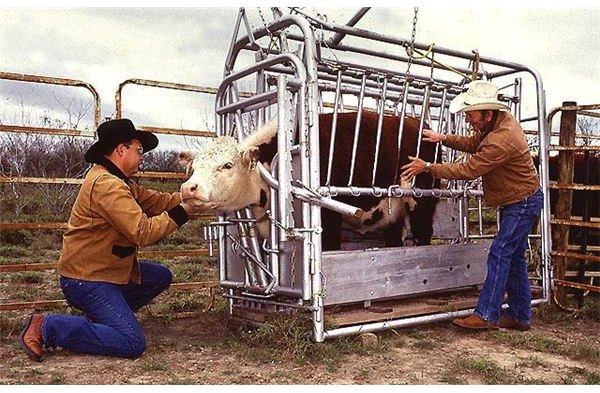About Investing in Beef Stocks & The Beef Cattle Market
Why Trade in Beef Stocks?
Buying and selling heads of cattle in the form of beef stocks is a multi-billion dollar industry in countries around the world. The trade of beef stocks represents roughly 23 percent of financial profitability of the entire cattle market, an estimated $30 billion as of the early 2000s. By investing in beef stocks, one takes on the position of handling one of the most recognized commodities throughout the world. Not only do the securities represent live head of cattle for slaughter, but also markets in dairy products such as milk, cheese, butter and yogurt as well as leather hides used to make everything from shoes and clothing to furniture. Cattle is one of the cornerstones of industry in most developing countries and considered a commodity in the developed world.
Above right: Cattle Being Inspected. (Supplied by the USDA; Public Domain; https://upload.wikimedia.org/wikipedia/commons/6/62/Cattle_inspected_for_ticks.jpg)
Where are Beef Stocks Traded?
In the United States, live cattle is sold on the Chicago Mercantile Exchange under the symbol of “LC.” It is traded in quantities of 40,000 pounds (20 tons). Feeder cattle is traded under the symbol of “FC” at a volume of 50,000 pounds (25 tons). On occasion, it is paired with other animal-based commodities such as lean hogs (LH) or frozen pork bellies (PB).
Live Cattle Options and Futures
The largest profit to be made by investing in beef stocks comes from the options and futures market. Both of these are standardized, exchange-traded contracts similar to those of other securities.
Live cattle options secure the right for an investor to take possession of a long position in which they can buy the commodity at a price in the future without obligation to do so. This is known as a call option. Investors can also establish a put option in which they have the right to sell at a later date at a contracted price.
Likewise, live cattle futures allows a buyer to take delivery of the product at a specific date in the future at an agreed-upon price. Essentially, this allows an investor to lock in a price regardless of the movement of the market. However, once the contract expires, the right to this deal with cease to exist. These deals can be conducted with actual sellers and buyers of beef stocks or by speculators.
Factors Impacting the Beef/Cattle Market
Numerous factors impact the price of beef stocks, however, none so much as recalls and problems with disease. When the US Department of Agriculture or some such organization warns the public of a problem with its beef supply, the price of live cattle generally takes a dip. This is especially bad when a serious illness like Mad Cow Disease is identified. This can cause the culling of whole herds of cattle and even result in the shutting down of borders for trade, greatly damaging the value of investing in beef stocks. In addition, the problems explode into other companies that may be in an investors portfolio, such as fast food companies or major food wholesalers.
Resources
“Live Cattle Options Explained” The Options Guide: https://www.theoptionsguide.com/live-cattle-options.aspx
“Mad Cow Scare Pushes US Beef Stocks Down” New Ratings: https://www.newratings.com/en/main/company_headline.m?&id=869523
This post is part of the series: Investing in Food Stock Commodities
Since the dawn of the stock market, foods have been traded amongst investors as a commodity. Since everyone needs to eat, these securities can provide a strong hedge against unseen fluctuations in the market.
